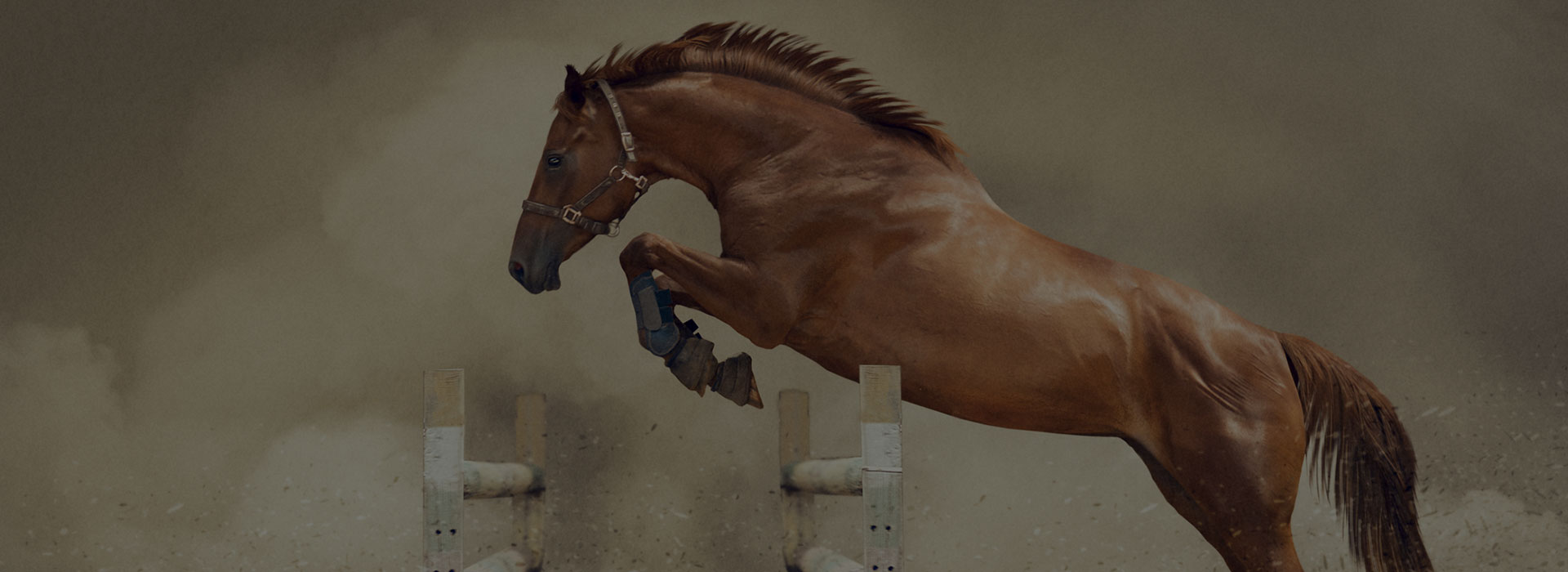26 Oct Castlereagh’s Guide on the Horse’s Digestive System
A horse is a non-ruminant herbivore. What this means is that even though it feeds on grass like cows and other ruminant herbivores do, it does not have multiple stomachs like its ruminant farm animal friends.
A horse’s digestive system is complex in its own right and requires no shortage of attention and maintenance.
It can be broken down into two main sections: the pr-caecal digestive system, which can be likened to that of a human. And the second part of its system, which is more similar to that of a cow.
Overall, a horse’s digestive system contains 6 main parts. They are:
- Mouth
- Oesophagus
- Stomach
- Small intestine
- Large Colon
- Small Colon, Rectum and Anus
In this article, we take you through each of these body parts and what they do. We also go over how you can promote a healthy digestive system for your horse.
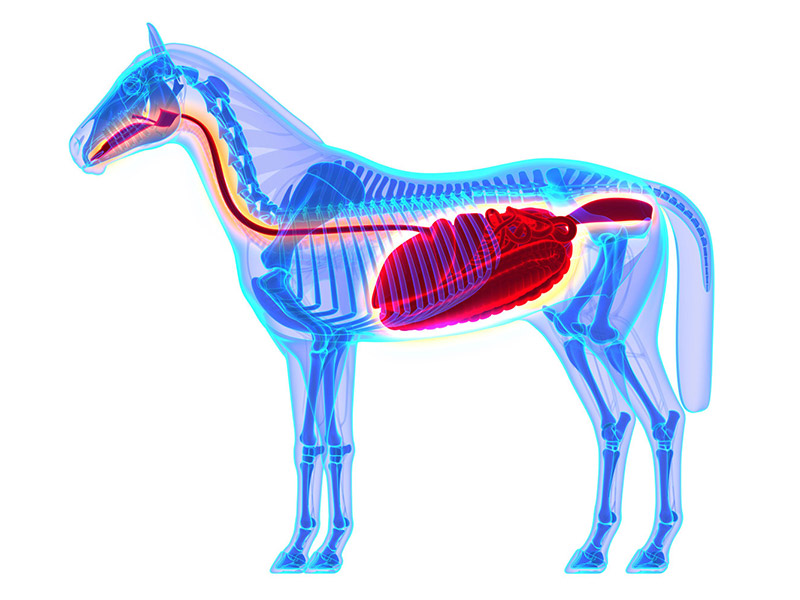
The Mouth

Naturally, all food enters the digestive system through the mouth – duh! Whereas humans chew their food to consume it, horses do things a little differently.
They use their lips, tongue and teeth, as well as saliva in their mouth to create a moist bolus, which the horse can then swallow with ease.
A horse that is fed regularly and allowed to forage adequately can produce between 20 and 80 litres of saliva per day.
Producing so much saliva helps protect amino acids in what is an otherwise highly acidic stomach. Additionally, it helps prevent stomach ulcers as well.
You may have seen that a horse’s chewing motion is a little weird, and that’s because its upper jaw is wider than its lower jaw.
The way a horse chews its food can be described as a sweeping motion, rather than vertical motions we humans typically use.
By moving their jaws almost horizontally in forwards and backwards sweeping motions, they are able to mix saliva with their food, so that it’s easier to digest.
This process is known as masticating. Essentially, horse’s need to make the bolus correctly, so that their food doesn’t get stuck in their oesophagus and cause them to choke.
That’s quite a bit that the horse has to go through just to get some food from its mouth and into its oesophagus.
The Oesophagus
Next up in the horse’s digestive system is its oesophagus. In a mature horse, the oesophagus is usually 1.5m long.
It may come as a surprise, but once food enters a horse’s oesophagus, it can only go one way – and that’s down. This is because horses don’t have the ability to vomit.
As a result, it’s important to maintain your horse’s teeth – to ensure that they chew their feed sufficiently and thus they don’t choke due to food getting lodged in their throat.
Stomach
The horse’s stomach is one of the more interesting parts of its digestive system, as the organ only takes up 10% of the capacity of its body.
That’s why horses need to eat small amounts of food many times per day. After all, the capacity of their digestive system is between 9 and 15 litres.
Unfortunately, the domestication of horses means that many are forced to eat in ways that are not natural to them i.e. large volumes of food once or twice per day.
This ultimately undermines the horse’s health, though most horse owners still go this route due to the economic benefits.
To keep your horse as healthy as possible, the best thing you can do is to assimilate natural grazing, which means feeding your horse small amounts multiple times per day.
A horse’s stomach is made up of three parts. Each has its own unique function, and food passes through each part before reaching the small intestine.
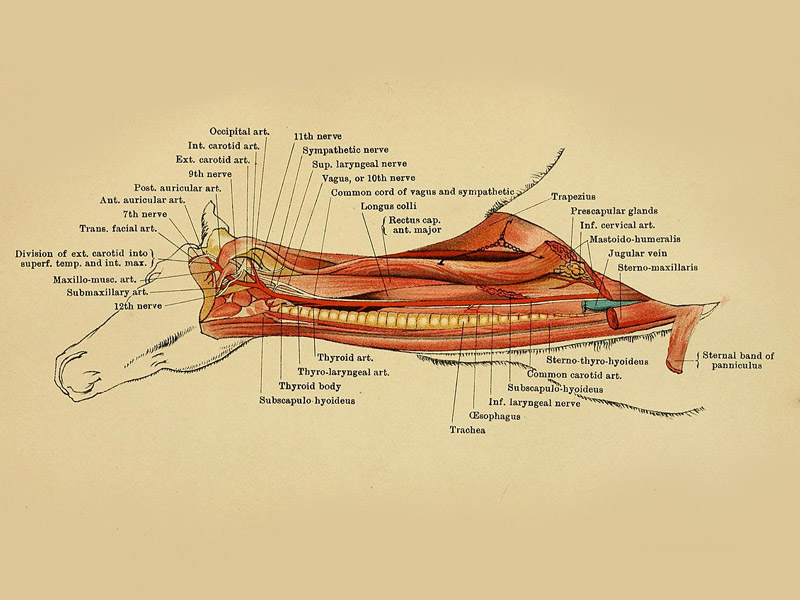
Small Intestine
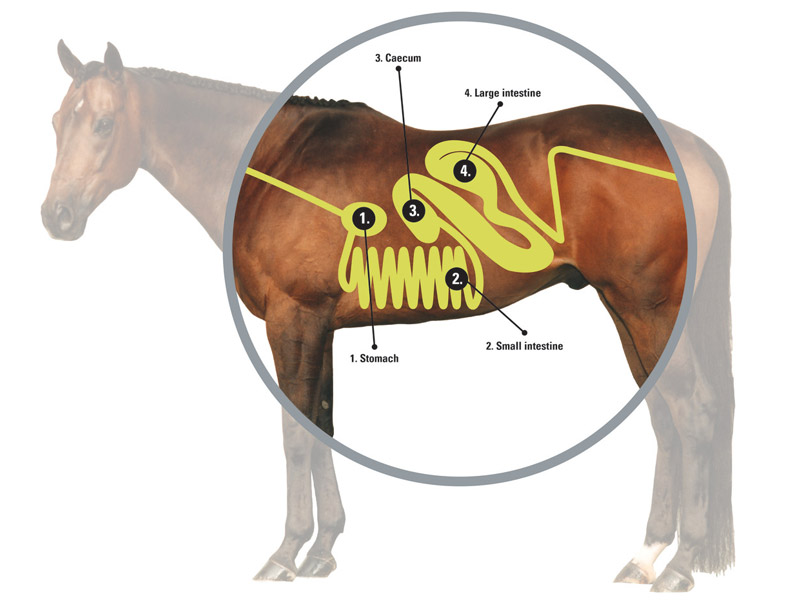
Once food has passes through the stomach, it then makes its way into the small intestine. This part of the horse’s digestive system is between 15 and 22m long in a mature horse.
Also broken into three parts, the small intestine is where most of the digestion occurs in modern day performance horses. In fact, little digestion at all happens in the stomach.
Food that is digested in this part of the horse’s digestive system is then absorbed through the walls of the small intestine.
Blood then carries off all nutrients to whatever cells need them most through the horse’s blood stream.
Food can pass through the small intestine in as little as between 30 and 60 minutes, though it typically takes between 3 and 4 hours.
Hind Gut
The hind gut is also known as the large intestine. This forms the bulk of a horse’s digestive system (around 62%), and consists of the following parts:
- Caecum – This part of the digestive system breaks down food that was not digested in the small intestine
- Large Colon – Food spends the most amount of time here (between 48-65 hours). It continues to break down here through the fermentation process.
- Small Colon – This part of the digestive system reclaims moisture from any remaining nutrients. Faecal balls are also formed here.
Indigestible faecal balls leave them small colon, pass through the rectum and leave the body as manure through the anus.
Horses and their Digestive Problems
When food enters a horse’s stomach, acids come into play to help break down the food enough, so that it can pass through to the small intestine.
Prolonged exposure to these acids ends up causing damage to the horse’s stomach lining, and common issues such as gastric ulcers arise.
General Signs of Digestive System Disorders
Like any other animal, or even a human baby, your horse will give off signs that something isn’t quite right when it has some digestive problems. These include:
- Excessive drooling
- Diarrhea
- Constipation or reduction in faeces
- Loss of appetite
- Bleeding
- Abdominal pain and bloating
- Shock
- Dehydration
- Straining to defecate
- Poor performance
One of the most common digestive problems is called Colic, and this occurs in the large colon. This causes severe abdominal pain. Your horse will show the following signs if it has Colic:
- Repeatedly pawing at the ground
- Kicking its own abdomen
- Rolling around on the ground
- Looking over at its flank
Infectious Diseases
Parasites are the most common cause of infectious diseases in horses. In fact, many different types are commonly found a horse’s digestive system.
These parasites are passed through the faeces of an infected horse as eggs and larva. When another horse eats the faeces, they then also become infected.
And yes, horses will eat manure if they have a poor feed program, are stressed, or even if they are bored.
Non-Infectious Diseases
Oftentimes, diseases in a horse’s digestive system are not cause by infective organisms such as parasites. Examples of non-infectious diseases include gastric ulcers and Colic.
Non-infectious diseases can be caused by overeating, a diet that consists of low-quality feed, injury to the digestive system, and swallowing foreign objects which get lodged in the digestive tract.
Unlike infectious diseases, non-infectious diseases are not passed from animal to animal. In most cases, only a single animal is infected
Treating Digestive System Disorders
In almost all cases, you will want to contact a veterinarian if you suspect that your horse is having problems with its digestive system. There are things that you can do to promote digestive health, though.
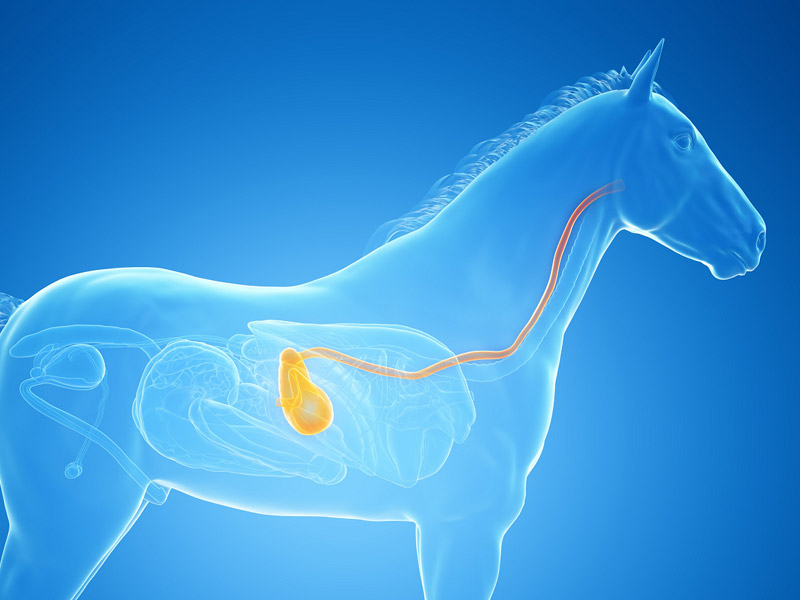
Promoting Your Horse’s Digestive Health
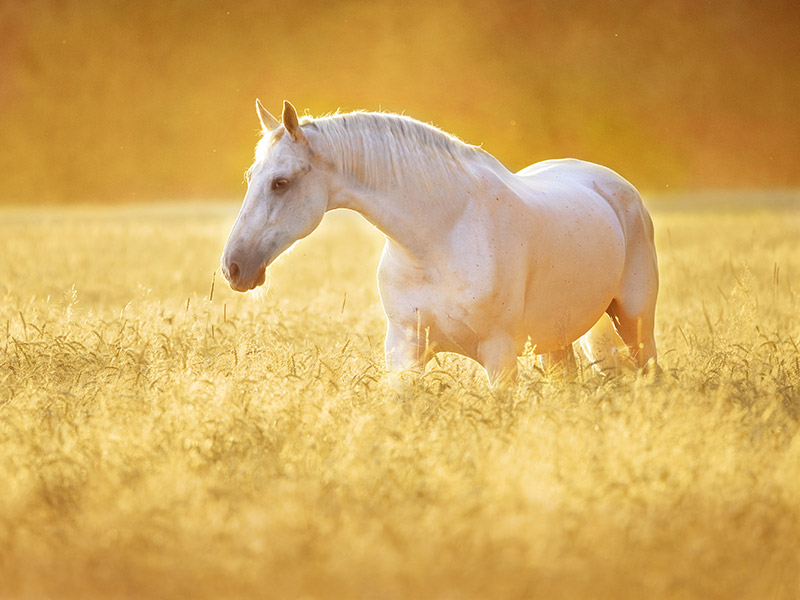
Thankfully, you can help your horse avoid discomfort, pain and unhappiness by actively promoting its digestive health. Below, we’ve outlined 5 things you can do to keep your horse happy and healthy.
Allow Your Horse to Forage Often
Long stem fibres like pasture and hay encourage your horse to chew more and thus produce more saliva.
Moreover, your horse will be eating for longer periods of time, ingesting smaller amounts of food at a time, and thus reducing the risk of gastric ulcers forming.
Feed Your Horse Small Amounts of Food
Horse’s naturally eat consistently over the course of the day and night. This means that they are trickle feeders.
Optimally, small amounts of feed should be reaching the horse’s small intestine, though this should be occurring constantly throughout the day.
By feeding your horse small amounts, the small intestine will not get overloaded, but it will be constantly absorbing nutrients into the horse’s body.
You should let your horse freely forage pasture and hay 24 hours per day, and also provide it with a fresh source of drinking water.
If you decide to feed your horse large meals, say twice per day, then you will inevitably overload the small intestine.
Food will then pass through the large intestine, and problems will occur when starch that is commonly found in feeds ends up here.
Minimise Starch
When your horse consumes too much starch, it runs a higher risk of suffering from gastric ulcers, as well as hindgut acidosis. Always look at your feed packaging, or contact the manufacturer to determine starch content.
In any case, feeds that are high in starch are typically low in fibre. You should always balance your horse’s diet. Though, if you can achieve your horse’s required nutritional intake through fibre alone, then we recommend you take that path.
If You Can’t Avoid Starch, Then Feed Cooked Starch
If you’re feeding your horse with grains such as wheat, barley and rice, then you should make sure that these are thoroughly cooked.
By doing so, you will minimise the amount of starch that is passing through to the hind gut, as once boiled, the only remaining starch will be that which can be digested via the small intestine.
Monitor Your Horse’s Water Intake
Always provide your horse with a constant source of clean and fresh drinking water. Make sure that the water is not too cold and not too hot.
Interesting Facts About the Horse’s Digestive System
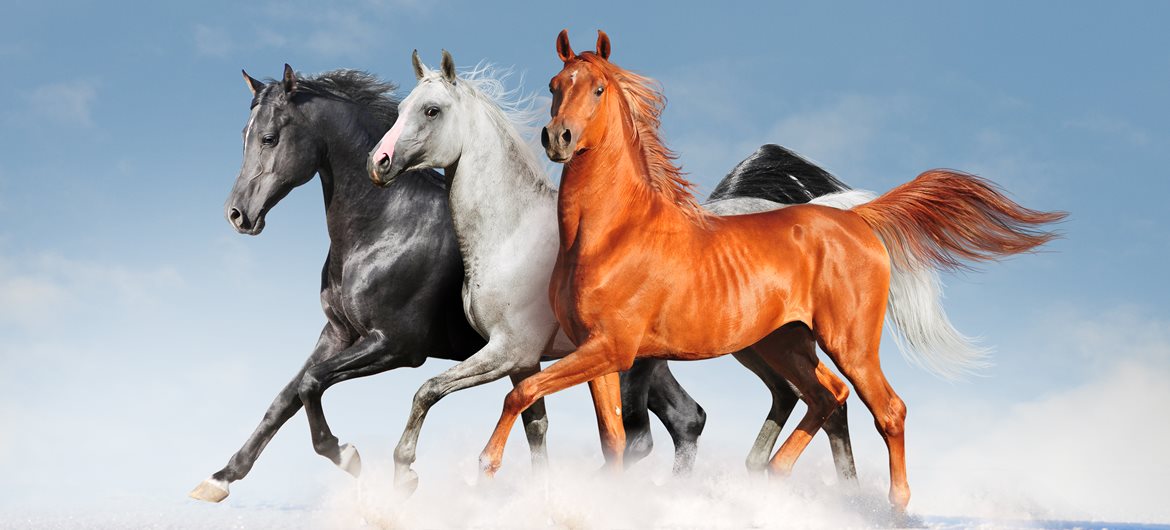
Now that you’ve gone through all of that info about the horse’s digestive system, we’ve decided to finish off this article with some facts that you may not have known until now.
Horses can only chew on one side of their mouth at a time
If you allow horses to forage enough, then they will produce as much as 37 litres of saliva per day
Horses can’t vomit. Their oesophagus only works in a single direction.
The horse’s stomach isn’t the largest part of its digestive system, and food spends about 15 minutes here on average. The rest of the time is spent in the small intestine and hind gut.
Horses do not have a gall bladder to store bile fluids. This goes directly to the horses small intestine and is constantly produced, whether the horse is eating or not. That’s why your horse should eat small amounts regularly.
On a daily basis, horses should consume a total 1% of their body weight in forage to promote a healthy digestive system.
Overall, food takes between 36 and 72 hours to pass through a horse’s digestive system.

